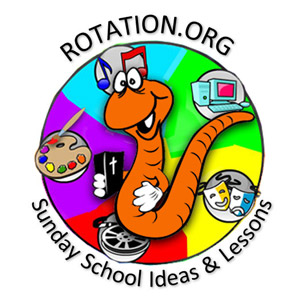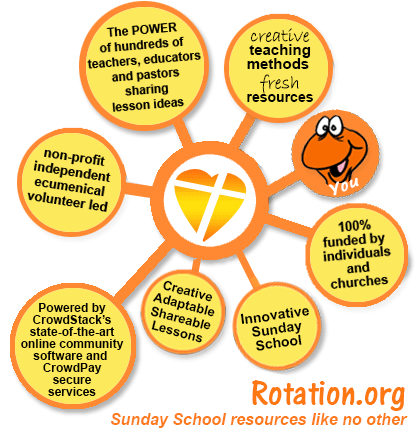Overview of the "Workshop" Lessons Posted Below:
Art: Children will create decorated tiles using alcohol inks.
Photography: Children will participate in an outdoor scavenger hunt taking photographs of God's creation.
Computers: Children will explore the story using Awesome Bible Stories software.
Video: Children will watch the “Story of Creation” (The Great Bible Discovery Series.)
Music & Movement: Children will retell the story using scarves and dramatic movement.
Cooking: Children will create Creation Snack Bags. (based on Seven Days of Creation Snack - Idea 1 posted here at Rotation.org
Scripture References:
Genesis 1 - 2:2
Memory Verse: “In the beginning, God created the heavens and the earth.” Genesis 1:1
Theme: God created the world and everything in it. We can learn about the character of God through the story of creation and thank God for the world he has given us to care for.
A Bible Background
People have always pondered the mystery of Creation. Why do I exist? What is the meaning of life? How did the universe come into being? Children are especially full of questions. Why is the sky blue? Why did God make giraffes? And a KEY question that nearly every child asks at some point.... If God made everything, who made God? (Here’s a good answer for that question: “Nobody. That’s who God is – the One who started it all, the One who made you and me and everything! God just is. He has always been. He always will be.
We all have questions. We don’t always have answers. Questions will be a big part of this rotation of lessons. When teaching children, it may be tempting to try to explain away the wonders and mysteries of Creation or to give simple, pat answers…. Accept that we won’t have answers to all of our questions, for God is bigger than we and God’s ways are not our ways. Embrace the mystery! Celebrate the wonder!
What is Genesis? Is it history? Does it give an accurate account of the earliest age of the universe? It is myth? Is this simply a symbolic story with little correspondence to real people, places and events? Perhaps we can best understand Genesis as writing of a different genre entirely. It is a PROCLAMATION of the love and majesty of God that through faith we experience through Creation. Rather than "how," the proclaimation helps us understand who God is, how God relates to his created order, and how we are to relate to God and the created order.
Like Creation itself, Genesis 1-2:2 is a Psalm of Awe, and a reminder of our place and role in God's universe.
As a United Methodist, I do not believe this Psalm of Awe opposes the modern scientific understanding of how the universe came to be, or how old it is. Genesis is poetry, not recipe. It is a Psalm, not court history. It is meant to move us and point us, rather than be dissected under an interpretative microscope. It is meant to remind us who is behind it all, and our role as stewards. Requiring Genesis to be read like history is like requiring Psalm 23 to be an actual story about a sheep, or a parable to have actually taken place. God's Word speaks through still small voices and mighty winds, stories about giants and whales, sinners and healing, death on a cross and an empty tomb. And God's Word speaks through scientific discovery -- to those with the ears and eyes of faith.
Themes in Genesis
The creation accounts in Genesis teach us about God.
- God is eternal – he has always existed. Before everything, there was God.
- God is in control -- God spoke and the universe came into being. God created all that is, seen and unseen. There was a definite beginning to the world. Before God spoke, the earth was formless and dark, a sort of cosmic emptiness.
- God is separate and distinct from his created order. This differs from Pantheism where God and the universe are one, where God is everything and everything is God.
- God is a personal God. He communicates. He is Sustainer as well as Creator. This contrasts with Deism, a belief system in which God creates, but then steps away and does not remain personally involved. (God does not wind up the world like a clock, set it in motion and then watch it wind down)
- God pays attention to detail. Think of the complexity and diversity of creation!
- God created humans in God’s image. We are the special objects of God’s love. We are heirs to all God has made. We are the center of his purpose, made to reflect God’s goodness, wisdom and love.
- God is purposeful. We live in a complex and ordered universe. There is purpose to our lives, as well.
- God’s creation is good. This differs from Gnosticism where only the spiritual component of life is good and the material and physical world is bad. Everything God made is good, therefore God himself must be VERY good!
- God created us to be stewards of the earth. We are responsible for caring for the earth, the plants, animals, air and water.
The Days of Creation
Rather than view these scientifically, or examine each day's meaning ad nauseum, it is better to view the days like strokes of paint being added to canvas to move us and remind us to whom we owe our life. The artist's purpose becomes clear on the 6th and 7th Days when a creature is made to enjoy fellowship with God and return his love by worshipping him and taking care of each other and the creation he has made.
Day One – Light and dark (day and night).
Day Two – Sky separated from the waters.
Day Three – Seas and dry land, plants and trees
Day Four – Sun, moon, stars
Day Five – Fish, sea creatures, birds
Day Six – Animals, man and woman
Day Seven – God rested




 You can use alcohol inks on any smooth, slick surface. We've also used them on vellum paper and photo type paper.
You can use alcohol inks on any smooth, slick surface. We've also used them on vellum paper and photo type paper.




 Awesome Bible Stories software program is now available FREE OF CHARGE to download here at Rotation.org to the supporting members of Rotation.org.
Awesome Bible Stories software program is now available FREE OF CHARGE to download here at Rotation.org to the supporting members of Rotation.org.


 Summary:
Summary:


